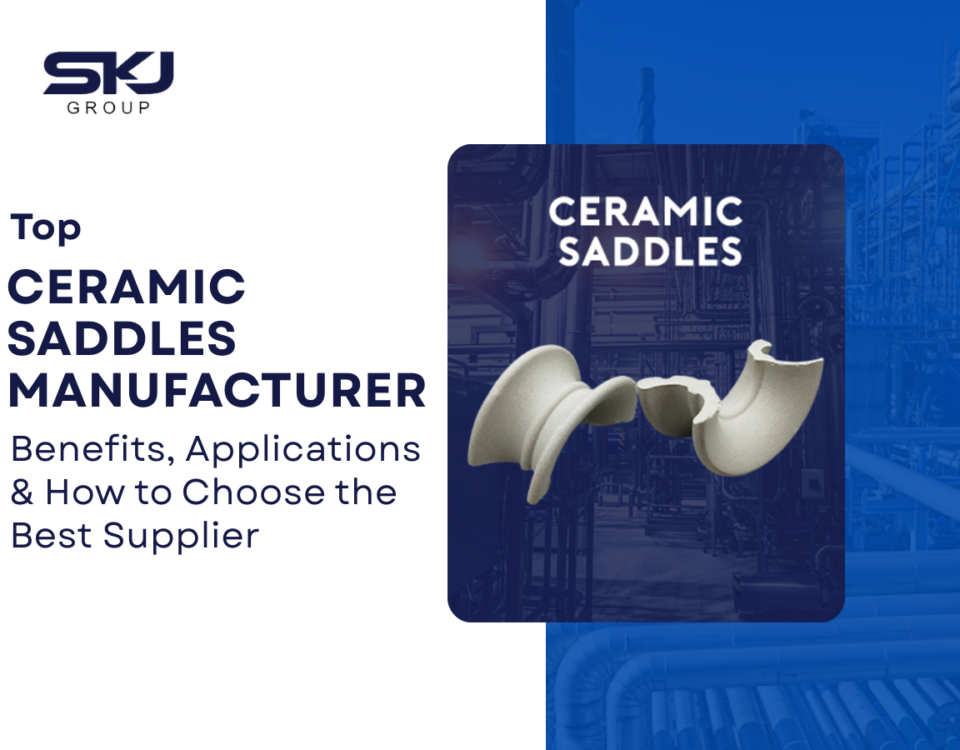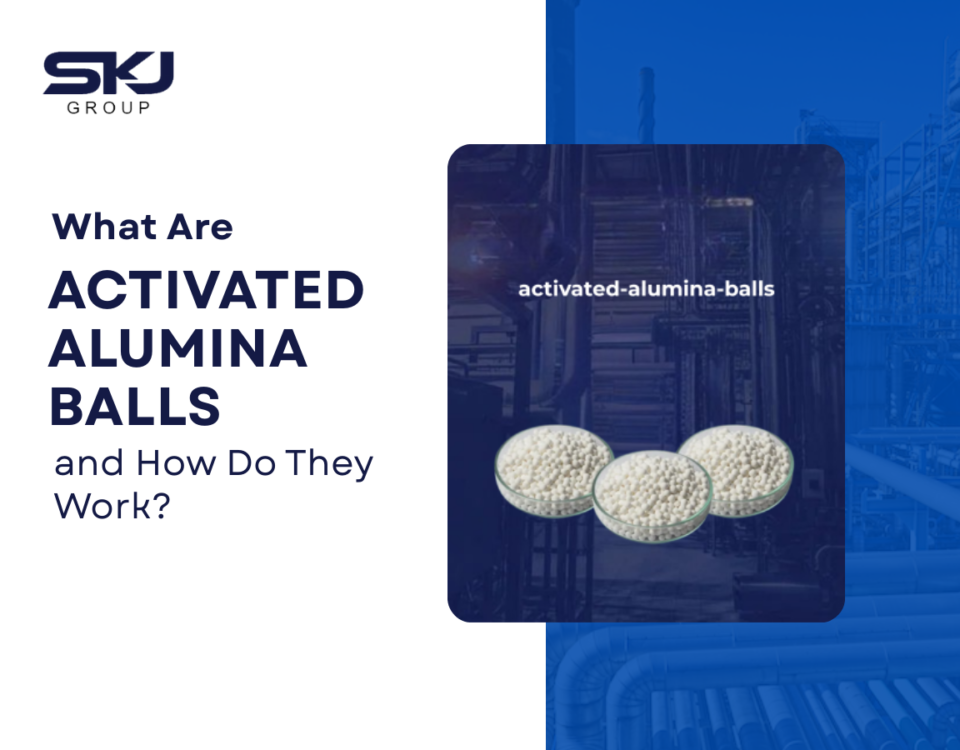How Ceramic Saddles’ Structure Enhances Performance in Chemical Engineering

Are there different grades of ceramic?
September 20, 2024
The Power of Intalox Saddles in Mass Transfer Applications
November 7, 2024In the chemical engineering industry, particularly in mass transfer and separation processes, the performance of packing materials plays a crucial role in determining operational efficiency. Among these materials, ceramic saddles stand out for their unique structure and design, which significantly impacts their performance in industrial applications. As a leading brand in industrial packing solutions,SKJ Group provide high-quality ceramic saddles that offer superior performance across various chemical engineering processes. This article will explore how the structure of ceramic saddles contributes to their effectiveness in industrial applications and why they are a preferred choice in many chemical processing plants.
What Are Ceramic Saddles?
Ceramic saddles are a type of random packing material commonly used in chemical engineering applications like distillation, absorption, and scrubbing. These saddles are designed to offer high surface area and mechanical strength, which allows them to enhance mass transfer processes while minimizing pressure drop and maintaining operational efficiency. The structure of ceramic saddles resembles a saddle-like shape, providing excellent liquid and gas distribution within a packed column.
Their resistance to chemical corrosion, high temperatures, and mechanical stress makes ceramic saddles a preferred choice in industries dealing with corrosive fluids or high-temperature operations. The combination of these structural benefits with their material properties makes ceramic saddles an essential component in chemical engineering applications.
The Unique Structure of Ceramic Saddles
The design of ceramic saddles is one of the most critical factors in their performance. Their unique saddle-like shape increases the packing’s overall surface area while maintaining a low-pressure drop. This section will explore the key features of their structure and how each contributes to their performance.
1. Shape and Geometrical Design
Ceramic saddles are characterized by their curved, saddle-like design. This unique shape is not just for aesthetics but serves critical engineering purposes. The saddle shape allows for better contact between the liquid and gas phases, which is essential in processes like distillation and absorption. The intricate geometry promotes efficient liquid distribution and enhances gas flow through the packed bed, leading to improved mass transfer rates. Additionally, the shape minimizes areas of low turbulence, which helps reduce the pressure drop across the packed column.
2. Surface Area and Porosity
A key factor in the performance of any packing material is the surface area it provides for the liquid and gas to interact. Ceramic saddles are designed with a large surface area relative to their volume, enhancing the contact between phases. This larger surface area facilitates better absorption and distillation processes by providing more space for the mass transfer to occur. Moreover, the open structure allows for high porosity, which improves the flow characteristics of the packed column and ensures even distribution of fluids.
3. Resistance to Clogging
One of the common challenges in chemical processing equipment is the clogging of packing material due to fouling or accumulation of particulate matter. The open, non-uniform structure of ceramic saddles makes them less prone to clogging. The saddle-like shape promotes good fluid flow and minimizes the risk of blockages. This structural feature is especially beneficial in processes where high-viscosity liquids or particles are present, as it ensures a more reliable and consistent operation over time.
4. Low Pressure Drop
In packed columns, maintaining a low-pressure drop is essential to reducing operational costs and ensuring efficiency. The structure of ceramic saddles is designed to offer minimal resistance to gas and liquid flow, leading to a lower pressure drop across the column. The curved and open design of the saddles minimizes turbulence and prevents the formation of stagnant zones. As a result, ceramic saddles help maintain optimal flow rates while minimizing energy consumption.
5. Mechanical Strength and Durability
The structure of ceramic saddles also contributes to their mechanical strength and durability. Ceramic as a material is known for its resistance to wear, mechanical stress, and chemical corrosion. The saddle structure distributes mechanical loads evenly, ensuring that the packing remains intact even under high-pressure or high-temperature conditions. This structural robustness makes ceramic saddles particularly suitable for applications in harsh industrial environments.
6. Heat and Chemical Resistance
Ceramic saddles are highly resistant to extreme temperatures and aggressive chemicals, which makes them an excellent choice for chemical engineering applications involving harsh operational conditions. Their unique structure enhances their ability to withstand thermal shocks, ensuring that the packing material remains effective even when subjected to rapid temperature changes. The saddle design also contributes to improved thermal conductivity, which is beneficial in processes where heat transfer is a critical factor.
Applications of Ceramic Saddles in Chemical Engineering
The structure of ceramic saddles plays a vital role in enhancing their performance across a wide range of chemical engineering applications. Below are some of the key applications where the unique structure of ceramic saddles proves beneficial.
1. Distillation Columns
In distillation columns, the goal is to separate components based on differences in their boiling points. Ceramic saddles provide a large surface area for the liquid and vapor to interact, which enhances the efficiency of the distillation process. The saddle structure ensures uniform liquid distribution and prevents channeling, leading to more efficient separation and higher product purity.
2. Absorption Towers
Absorption towers are used to remove specific components from a gas stream by dissolving them into a liquid. Ceramic saddles, with their high surface area and excellent liquid distribution properties, enhance the absorption process. The structure promotes efficient gas-liquid contact, increasing the absorption rate while minimizing pressure drop, making ceramic saddles ideal for this application.
3. Scrubbing Systems
In scrubbing systems, gas streams are purified by passing through a liquid that absorbs or neutralizes pollutants. The open structure and large surface area of ceramic saddles make them highly effective in scrubbing applications. They facilitate good gas-liquid contact and ensure that the scrubbing liquid is evenly distributed, which improves the overall efficiency of the system.
4. Heat Transfer Applications
In some chemical processes, ceramic saddles are used to improve heat transfer between phases. The unique structure of the saddles enhances the thermal conductivity of the packed bed, making them suitable for applications where both mass and heat transfer are critical. Their resistance to thermal shock also ensures that they remain effective in high-temperature environments.
5. Chemical Reaction Processes
In catalytic reactors or packed bed reactors, ceramic saddles are often used to provide a large surface area for catalytic reactions. The open structure allows reactants to flow freely through the packing while ensuring that they come into contact with the catalyst. This improves reaction rates and ensures efficient utilization of the catalyst.
Advantages of Ceramic Saddles
The unique structure of ceramic saddles offers several advantages in chemical engineering applications:
- High Mass Transfer Efficiency: The large surface area and excellent liquid distribution properties of ceramic saddles enhance mass transfer, leading to more efficient separation and absorption processes.
- Low Pressure Drop: The saddle-like design minimizes turbulence and reduces pressure drop, which helps lower operational costs and improve process efficiency.
- Resistance to Fouling and Clogging: The open structure of ceramic saddles reduces the risk of clogging, ensuring consistent operation over time.
- Durability and Strength: Ceramic saddles are highly resistant to mechanical stress, chemical corrosion, and high temperatures, making them suitable for use in harsh industrial environments.
- Cost-Effectiveness: The long lifespan and minimal maintenance requirements of ceramic saddles make them a cost-effective choice for many chemical processing applications.
Why Choose SKJ Group?
SKJ Group are industry leaders in the production of high-quality ceramic saddles. Their products are designed with precision and undergo rigorous quality control to ensure that they meet the demands of modern chemical engineering applications. By choosing ceramic saddles from these trusted brands, industries can benefit from superior performance, long-lasting durability, and reliable operation.
Conclusion
The structure of ceramic saddles plays a fundamental role in their performance in chemical engineering applications. Their saddle-like design provides a high surface area, excellent liquid and gas distribution, and resistance to clogging, all of which contribute to enhanced mass transfer and operational efficiency. The mechanical strength and durability of ceramic saddles also make them ideal for use in harsh industrial environments where chemical corrosion and high temperatures are common.




